Signal packet grounding and crosstalk
Time:2022-11-02
Views:1633
Protective ground wire is often used for isolation in engineering to suppress mutual interference between signals. It is true that the protective ground wire can sometimes improve the isolation between signals, but the protective ground wire is not always effective, and sometimes even worsens the interference. The use of protective ground wire must be carefully analyzed and handled according to the actual situation.

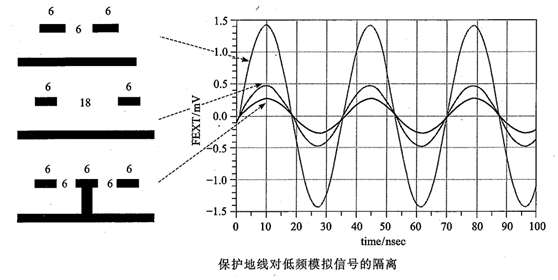

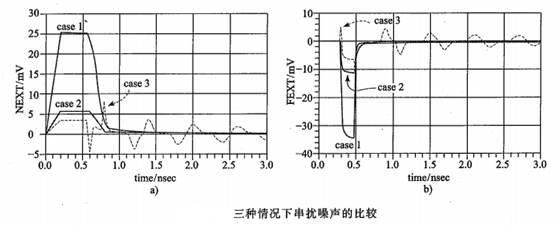
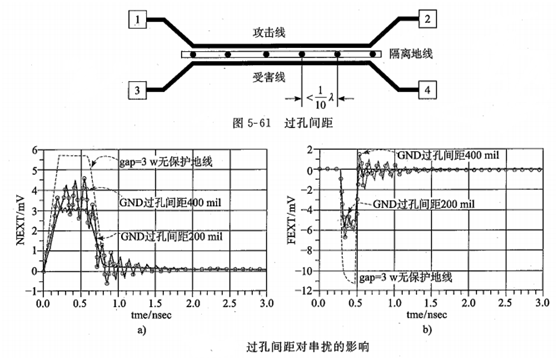
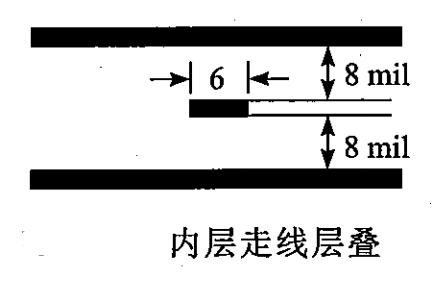

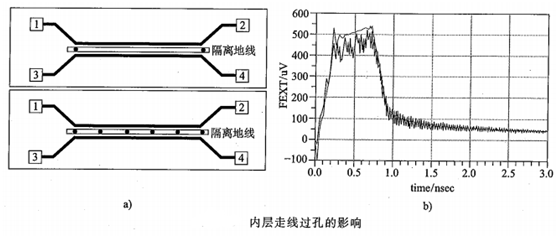
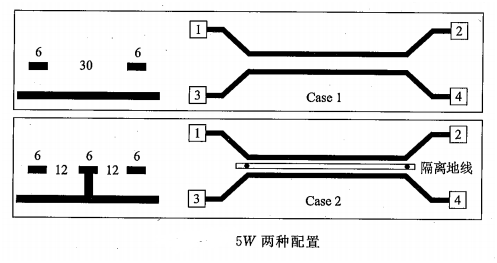
Protective ground wire refers to inserting a GND routing wire between two signal lines to isolate the two signals. GND vias are punched at both ends of the ground wire to connect with the GND plane, as shown in the figure. Sometimes protective ground wires are placed on both sides of sensitive signals.

In order to add a protective ground wire, the space between the two signal lines must be extended to enough space to accommodate a protective ground wire. Because the space between the signal lines is extended, the crosstalk will be reduced even if the protective ground wire is not inserted. How useful would inserting a protective ground wire be?
Low frequency analog signal packet ground
Let‘s look at the crosstalk in the case of surface microstrip lines. Assume that the wiring is 50 Ω impedance controlled, the line width is 6 mil, the dielectric thickness is 3.6 mil, and the dielectric constant is 4.5. It is assumed that both signals are analog signals with carrier frequency of 30Mhz and bandwidth of 2Mhz.
The figure below shows the remote crosstalk in three cases. When the line spacing is 6 6mil, the far end crosstalk is large because the two lines are closely coupled. When the distance is increased to 18mil, the far end crosstalk is significantly reduced. Furthermore, a protective ground wire is added between the two lines, and both ends of the ground wire are connected to the ground with vias, so that the far end crosstalk is further reduced.

Protective grounding is really useful for isolation between low-frequency analog signals. This is also the reason why many low-frequency boards often see "ground wrapping". However, if isolated digital signals are required, the situation will be different. We discuss the isolation effect of protective ground wire on digital signals in two cases: surface microstrip line and inner stripline. In the following discussion, I do not assume that PCB routing is controlled by 50 Ω impedance.
Surface routing
The above surface layer wiring stack structure is still used. The line width is 6mil, the dielectric thickness is 3.6mil, and the dielectric constant is 4.5. The attack signal is a step waveform with rise time Tr=200ps. Consider the near end crosstalk and far end crosstalk in the following three cases, as shown in the figure below, where the coupling section length is 2000mil.
Case1: distance between two lines gap=1w (w=6mil indicates line width);
Case2: The distance between the two routing lines gap=3w. Only the main road can lay down the distance between one protective line, but it is not applicable to the protective line;
Case3: The spacing between two lines is gap=3w, protective ground wire is used in the middle, and GND vias are punched at both ends.

The figure below shows the crosstalk waveform under three conditions. Whether it is near end crosstalk or far end crosstalk, the crosstalk will decrease significantly when the line spacing increases from 1w to 3w. On this basis, the protective ground wire is inserted between the wires. The crosstalk is shown in Case 3 below. Compared with Case 2, the protective ground wire does not further reduce crosstalk, but increases crosstalk noise.

This example shows that pulling the distance between wires is an effective way to reduce crosstalk. If the protective ground wire is used improperly, it may worsen the crosstalk. Therefore, when using protective ground wire, careful analysis should be made according to the actual situation. The protective ground wire should think of its isolation function, and many GND vias need to be added to the ground wire, and the spacing between vias should be less than 1/10 λ, As shown in the figure. λ Is the wavelength corresponding to the frequency component of the signal.

Inner layer wiring
For inner layer routing, see the figure below:

The dielectric constant is 4.5 and the impedance is 50 Ω. Consider the following three situations. The attack signal is a step waveform with rise time Tr=200ps. The amplitude of the incident signal is 500mv, and the coupling length is 2000mil. The near end crosstalk is as shown in the figure. The protective ground wire is added, and the near end crosstalk is further reduced from 3.44mV to 0.5mV. The signal isolation is improved by 16B. For inner layer wiring, adding protective ground wire can obtain greater isolation.

For surface routing, the use of dense GND vias is beneficial to improve the isolation effect. However, for the inner layer wiring, the use of dense GND vias can hardly gain additional benefits. The figure below compares the near end crosstalk when the GND vias spacing is 2000 mils (GND vias are punched at both ends of the protective ground wire) and the GND vias spacing is 400 mils. The crosstalk amount has almost no change.

What happens when the spacing increases to 5w?
When the line spacing is further increased and the protective ground wire is still kept at the line width of 6mil, the protective ground wire will play a smaller role in surface layer routing. In the figure below, when the distance between the two lines is 5w, the near end crosstalk and far end crosstalk are equivalent to those without protective ground wire, and there is no significant improvement. Therefore, for surface routing, when the spacing is large, adding protective ground wire in the middle has little effect. If it is not handled well, it will worsen the crosstalk.
For the inner layer wiring, the protective ground wire will still play a great role. As shown in the figure below, the inner layer spacing is 5W, and the near end crosstalk noise waveform in both cases is shown in the figure. The protective ground wire is added in the middle, which can obviously improve the near end crosstalk.

Conclusion
1. The protective ground wire is usually effective for isolating low-frequency analog signals. But the protective wiring between digital signals is not so useful, sometimes it will make the situation worse.
2. For surface routing, if the GDN hole spacing of protective ground wire is large, the crosstalk may be more serious, and very dense GND holes must be used for isolation.
3. For the inner layer wiring, the protective ground wire can reduce the near end crosstalk.
|
Disclaimer: This article is transferred from other platforms and does not represent the views and positions of this site. If there is any infringement or objection, please contact us to delete it. thank you! |











